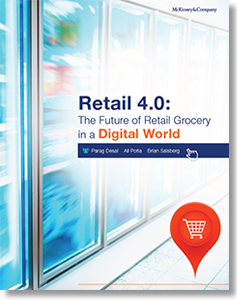The Future of Retail Grocery in a Digital World
McKinsey’s Future of Retail Grocery in a Digital World highlights the major trends that define this new period of retail and looks at how traditional retailers need to evolve in order to thrive.
If there’s one thing that always stays the same in retail, it’s change. Since the birth of the first modern supermarket in Memphis, Tennessee in 1916, grocery retail has gone through three transformational eras.
The fourth, and arguably most challenging era - the dawn of digital and omni-channel retailing - is just beginning.
The report focuses on the grocery sector, but also draws on the best practices and experiences of leading retailers in different categories from around the world.
Making Sense of Retail 4.0
With the usage of PCs, tablets and mobile phones becoming almost universal in the developed economies, the rules of the retail game are rapidly changing. Customers have a new set of expectations for how they go about their shopping.
They want experiences that stretch seam¬lessly across various channels and that can be accessed whenever and however they choose No longer niche, e-commerce is becoming a necessary strategy for traditional grocers. As the upstart “e-grocery attackers” become adept at their game, brick-and-mortar stores that don’t adapt may be left to play in the convenience store/food service game, selling low-margin products.
Like every other seismic shift in retail, era 4.0 will transform the very concept of what a store is. Smart retailers are blurring the lines between offline and online, experimenting with virtual stores embedded in physical ones (the “endless aisle”) and scannable product codes on subway station walls. They’re reimagining stores as distribution centers that can offer customers same-day delivery and they’re trying new delivery models, such as drive-throughs where customers can order items online and then pick them up without having to leave their car. All this could mark the death of the big box retailer as we know it.
Gone, too, are the simple days of coupon-cutting. Discount offers and other promotions are evolving into targeted personal offers using a variety of channels, from print-outs to smart phone apps. For a long time, many grocery retailers barely marketed their brand at all, relying instead on in-store merchandising and coupons published in flyers. Today, marketing and brand building is no longer confined to what happens within the four walls of a store. Social media sites, for instance, offer retailers an opportunity to not only develop their brand image, but engage in real-time customer service.
In the future, credit cards and cash registers may be obsolete, offering both the promise of quicker checkouts for customers and increased profits for retailers. Mobile-based payment systems are approaching critical scale through NFC (near field communications) technology, or mobile wallets. When customers have this technology enabled on their smartphones, they only need a phone, instead of a credit card, to make a purchase. Similarly, innovative retailers are installing iPads at the checkout and giving these and other mobile devices to store managers and shop floor workers, helping to boost customer service and increase store efficiency.
The capabilities required to win in retail 4.0 will continue to evolve rapidly. The innovations of retail’s previous era (e.g., new loyalty schemes, more efficient supply chains) will quickly become antes to play. New expertise that combines technology-, marketing- and merchan¬dising-savvy, however, will define the game itself.
What’s Related




Favorites





